I. The Real Economy - ആർബിഐ - Reserve Bank of India
I. The Real Economy
The Indian economy recorded an impressive performance during the first quarter of 2005-06. According to the Central Statistical Organisation (CSO), real GDP growth in the first quarter (April-June) of 2005-06 accelerated to 8.1 per cent from 7.6 per cent in the corresponding period of the preceding year. The improved performance in real activity was propelled by the double-digit growth in industrial activity and robust services sector. Industrial activity was mainly led by the manufacturing sub-sector. The expansion of services sector continued to be spearheaded by the sub-sector ‘trade, hotels, restaurants, transport, storage and communication’, and supported by ‘financing, insurance, real estate and business services’ and construction. Real GDP originating from the ‘agriculture and allied activities’, however, remained subdued reflecting the adverse impact of the uneven monsoon during 2004-05 (Table 1).
Against the backdrop of the economic performance in the first quarter, developments in the real economy during 2005-06 so far covering the agricultural situation, the progress of the South-West monsoon, industrial production, business and investment expectations and the lead indicators of service sector activity are presented in this section.
Table 1: Growth Rates of Real GDP
|
(Per cent) |
|||||||||||
|
Sector |
1993-94 to |
2003- |
2004- |
2004-05 |
2005-06 |
||||||
|
2002-03 |
04* |
05# |
|||||||||
|
(Average) |
Q1 |
Q2 |
Q3 |
Q4 |
Q1 |
||||||
|
1 |
2 |
3 |
4 |
5 |
6 |
7 |
8 |
9 |
|||
|
1. |
Agriculture and Allied Activities |
2.1 |
9.6 |
1.1 |
3.8 |
0.0 |
-0.5 |
1.8 |
2.0 |
||
|
(26.5) |
(21.7) |
(20.5) |
|||||||||
|
1.1 |
Agriculture |
2.0 |
10.3 |
N.A |
|||||||
|
2. |
Industry |
6.6 |
6.5 |
8.3 |
7.6 |
9.1 |
9.2 |
7.3 |
10.1 |
||
|
(22.1) |
(21.6) |
(21.9) |
|||||||||
|
2.1 |
Mining and Quarrying |
4.7 |
6.4 |
4.5 |
6.9 |
4.7 |
4.5 |
2.5 |
3.2 |
||
|
2.2 |
Manufacturing |
7.1 |
6.9 |
9.2 |
7.9 |
9.6 |
10.5 |
8.6 |
11.3 |
||
|
2.3 |
Electricity, Gas and Water Supply |
5.2 |
3.7 |
5.5 |
6.1 |
9.1 |
4.4 |
2.6 |
7.9 |
||
|
3. |
Services |
7.8 |
8.9 |
8.6 |
9.1 |
7.7 |
8.8 |
8.8 |
9.6 |
||
|
(51.4) |
(56.7) |
(57.6) |
|||||||||
|
3.1 |
Trade, Hotels, Restaurants, |
||||||||||
|
Transport, Storage and |
|||||||||||
|
Communication |
8.8 |
11.8 |
11.4 |
11.5 |
12.3 |
10.8 |
11.1 |
12.4 |
|||
|
3.2 |
Financing, Insurance, Real |
||||||||||
|
Estate and Business Services |
8.0 |
7.1 |
7.1 |
7.0 |
5.5 |
8.2 |
7.7 |
8.3 |
|||
|
3.3 |
Community, Social and |
||||||||||
|
Personal Services |
6.9 |
5.8 |
5.9 |
8.2 |
3.0 |
5.6 |
7.2 |
6.1 |
|||
|
3.4 |
Construction |
5.7 |
7.0 |
5.2 |
5.0 |
4.6 |
7.2 |
4.1 |
7.9 |
||
|
4. |
Real GDP at Factor Cost |
6.0 |
8.5 |
6.9 |
7.6 |
6.7 |
6.4 |
7.0 |
8.1 |
||
|
(100) |
(100) |
(100) |
|||||||||
|
*: Quick Estimates. #: Revised Estimates. N.A: Not Available. |
|||||||||||
Agricultural Situation
According to the India Meteorological Department (IMD) forecast on July 6, 2005, the rainfall during the South-West monsoon season (June-September) 2005, for the country as a whole, was likely to be 98 per cent of the Long Period Average (LPA) with a model error of +/- 5 per cent. The progress of the monsoon was weak till June 22, 2005, with cumulative rainfall being 49 per cent below normal. In the subsequent period, monsoon picked up, offsetting the earlier shortfall. The cumulative rainfall recorded during the season (June 1 to September 30, 2005) was, thus, only one per cent below normal as compared with 13 per cent below normal during the corresponding period of the previous year. Of the 36 meteorological sub-divisions, cumulative rainfall was excess/normal in 32 subdivisions (23 sub-divisions during last year) and deficient in 4 sub-divisions (13 sub-divisions during last year) (Chart 1). At the district level, 65 percent of the total number of districts received excess/normal rainfall, while the rest received deficient rain. Concomitantly, the total live water storage as on October 14, 2005 in the 76 major reservoirs1 monitored by the Central Water Commission improved significantly to 81 per cent of the Full Reservoir Level (FRL) as compared with 65 per cent a year ago.
Kharif sowing which had been initially adversely affected due to delayed and weak monsoon picked up with the revival of the monsoon. Accordingly, as on October 10, 2005, the area coverage in the case of all major crops except for coarse cereals and oilseeds was higher than that in the previous year. However, area coverage under oilseeds was higher compared to its normal sown area (Table 2).
According to the First Advance Estimates released by the Ministry of Agriculture on September 16, 2005, total kharif foodgrains production during
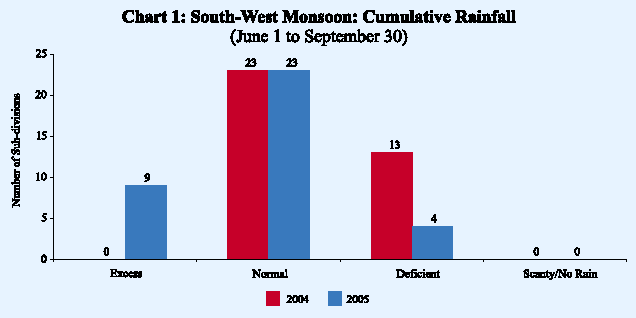
1 These reservoirs account for 63 per cent of the total reservoir capacity of the country.
Table 2: Progress of Area under Kharif Crops - 2005-06
|
(Million hectares) |
||||
|
Crop |
Normal Area |
Area Coverage (As on October 10) |
||
|
2004 |
2005 |
Variation |
||
|
1 |
2 |
3 |
4 |
5 |
|
Rice |
39.9 |
34.7 |
36.1 |
1.4 |
|
Coarse Cereals |
22.9 |
22.5 |
21.8 |
-0.7 |
|
Of which : |
||||
|
Bajra |
9.3 |
9.0 |
8.2 |
-0.8 |
|
Jowar |
4.6 |
3.9 |
3.8 |
-0.1 |
|
Maize |
6.0 |
7.1 |
7.3 |
0.2 |
|
Pulses |
10.6 |
11.0 |
11.2 |
0.2 |
|
Cotton |
8.3 |
8.5 |
8.5 |
0.0 |
|
Kharif Oilseeds |
15.1 |
17.8 |
17.3 |
-0.5 |
|
Of which : |
||||
|
Groundnut |
5.5 |
5.7 |
5.6 |
-0.1 |
|
Soyabean |
6.3 |
8.0 |
7.7 |
-0.3 |
|
Sesamum |
1.6 |
1.9 |
1.8 |
-0.1 |
|
Niger |
0.5 |
0.4 |
0.3 |
-0.1 |
|
Sugarcane |
4.3 |
3.8 |
4.1 |
0.3 |
|
All Crops |
101.0 |
99.0 |
99.9 |
0.9 |
|
Source: Ministry of Agriculture, Government of India. |
||||
2005-06 at 105.3 million tonnes will be marginally higher (1.9 per cent) than last year but notably lower than that achieved in 2003-04 (Tables 3 and 4). The increase in the foodgrains production is expected to emanate mainly from higher output of rice and maize. Among the commercial crops, the output of oilseeds and cotton is estimated to decline while that of sugarcane is expected to show a significant improvement.
Table 3: Kharif Production: 2005-06
|
(Million tonnes) |
|||
|
Crops |
2004-05* |
2005-06** |
Variation (Per cent) |
|
1 |
2 |
3 |
4 |
|
Total Foodgrains |
103.3 |
105.3 |
1.9 |
|
Rice |
71.7 |
73.8 |
2.9 |
|
Coarse Cereals |
26.7 |
26.4 |
-1.1 |
|
Of which : |
|||
|
Jowar |
4.0 |
3.9 |
-2.5 |
|
Bajra |
8.1 |
7.8 |
-3.7 |
|
Maize |
11.6 |
12.2 |
5.2 |
|
Pulses |
5.0 |
5.0 |
0.0 |
|
Other Kharif Pulses |
2.4 |
2.7 |
12.5 |
|
Tur |
2.6 |
2.3 |
-11.5 |
|
Oilseeds |
14.9 |
14.6 |
-2.0 |
|
Of which : |
|||
|
Groundnut |
5.3 |
5.9 |
11.3 |
|
Soyabean |
7.5 |
6.6 |
-12.0 |
|
Cotton# |
17.0 |
15.9 |
-6.5 |
|
Jute@ |
9.6 |
9.2 |
-4.2 |
|
Mesta@ |
0.9 |
0.9 |
0.0 |
|
Sugarcane |
232.3 |
257.7 |
10.9 |
|
# : Million bales of 170 kgs. each. |
|||
Table 4: Agricultural Production
|
(Million tonnes) |
|||||||
|
Crop |
2003-04 |
2004-05 |
|||||
|
T |
A |
T |
A $ |
||||
|
1 |
2 |
3 |
5 |
6 |
|||
|
Rice |
93.0 |
88.3 |
93.5 |
85.3 |
|||
|
Wheat |
78.0 |
72.1 |
79.5 |
72.0 |
|||
|
Coarse Cereals |
34.0 |
38.1 |
36.8 |
33.9 |
|||
|
Pulses |
15.0 |
14.9 |
15.3 |
13.4 |
|||
|
Total Foodgrains |
220.0 |
213.5 |
225.1 |
204.6 |
|||
|
Kharif |
111.7 |
116.9 |
113.8 |
103.3 |
|||
|
Rabi |
108.3 |
96.6 |
111.3 |
101.3 |
|||
|
Total Oilseeds |
24.7 |
25.3 |
26.2 |
26.1 |
|||
|
Kharif |
14.7 |
16.8 |
16.3 |
14.9 |
|||
|
Rabi |
10.0 |
8.5 |
9.9 |
11.2 |
|||
|
Sugarcane |
320.0 |
237.3 |
270.0 |
232.3 |
|||
|
Cotton # |
15.0 |
13.9 |
15.0 |
17.0 |
|||
|
Jute and Mesta ## |
12.0 |
11.2 |
11.8 |
10.5 |
|||
|
T : Target. A : Achievement. $:Fourth Advance Estimates. |
|||||||
Food Management
The total procurement of rice and wheat during 2005-06 (up to September 29, 2005) at 19.6 million tonnes was 8.0 per cent lower than that in the corresponding period of the previous year. The total off-take of foodgrains during 2005-06 (April 1 to August 31, 2005) at 15.9 million tonnes was also lower by 3.2 per cent over the corresponding period of the preceding year, mainly due to a sharp fall in the off-take under the Open Market Sales (OMS) including exports and the Targeted Public Distribution System (TPDS) (Table 5). Reflecting the lower procurement, the total stocks of foodgrains with the Food Corporation of India (FCI) and the State agencies stood at around 19.2 million tonnes as on September 1, 2005, about 16.5 per cent lower than a year ago.
Industrial Performance
Industrial activity gathered further strength during the first five months of 2005-06, although there was some loss of momentum during July-August 2005. During April-August 2005, industrial production accelerated to 8.8 per cent led by the manufacturing sector (Chart 2). Electricity and mining sectors, on the other hand, recorded a deceleration. Slowdown in the mining sector may be attributable in part to the decline in production of crude oil caused by break-out of fire in the Mumbai-High oil field. Lower growth in electricity sector is attributable to shortages of coal and gas.
According to the use-based classification, basic goods recorded moderate pick-up benefiting from strong growth of cement and basic metal and alloy industries. Capital goods growth remained robust on the back of strong investment demand in the economy. The marginal deceleration during April-August 2005 could be attributed to high-base effect as also slow down in growth of machinery and equipment. Consumer goods recorded an impressive double-digit growth led largely
Table 5: Management of Food Stocks
|
(Million tonnes) |
||||||||||||
|
Opening Stock of |
Procurement of |
Foodgrains Offtake |
Closing |
Norms |
||||||||
|
Foodgrains |
Foodgrains |
Stock |
||||||||||
|
Month |
Rice |
Wheat |
Total |
Rice |
Wheat |
Total |
PDS |
OWS |
OMS - |
Exports |
||
|
Domestic |
||||||||||||
|
1 |
2 |
3 |
4 |
5 |
6 |
7 |
8 |
9 |
10 |
11 |
12 |
13 |
|
2004 |
||||||||||||
|
April |
13.1 |
6.9 |
20.7 |
1.2 |
14.5 |
15.7 |
2.0 |
0.5 |
0.0 |
0.3 |
32.4 |
15.8 |
|
May |
12.7 |
19.0 |
32.4 |
1.3 |
1.7 |
3.0 |
2.3 |
0.6 |
0.0 |
0.1 |
32.3 |
|
|
June |
12.3 |
19.4 |
32.3 |
0.9 |
0.5 |
1.4 |
2.3 |
1.0 |
0.0 |
0.1 |
30.6 |
|
|
July |
10.8 |
19.2 |
30.6 |
0.4 |
0.1 |
0.5 |
2.4 |
1.0 |
0.0 |
0.1 |
27.2 |
24.3 |
|
August |
9.1 |
17.4 |
27.2 |
0.5 |
0.0 |
0.5 |
2.4 |
1.0 |
0.0 |
0.1 |
23.0 |
|
|
September |
7.1 |
15.8 |
23.0 |
0.2 |
0.0 |
0.2 |
2.5 |
1.0 |
0.0 |
0.1 |
20.3 |
|
|
October |
6.1 |
14.2 |
20.3 |
6.2 |
0.0 |
6.2 |
2.4 |
0.8 |
0.0 |
0.0 |
23.7 |
18.1 |
|
November |
11.0 |
12.6 |
23.7 |
2.7 |
0.0 |
2.7 |
2.4 |
0.6 |
0.0 |
0.0 |
21.8 |
|
|
December |
11.1 |
10.7 |
21.8 |
2.6 |
0.0 |
2.6 |
2.6 |
0.7 |
0.0 |
0.0 |
21.7 |
|
|
2005 |
||||||||||||
|
January |
12.8 |
8.9 |
21.7 |
3.9 |
0.0 |
3.9 |
2.7 |
0.8 |
0.0 |
0.0 |
21.6 |
16.8 |
|
February |
14.2 |
7.3 |
21.6 |
2.3 |
0.0 |
2.3 |
2.7 |
0.9 |
0.0 |
0.0 |
20.0 |
|
|
March |
13.7 |
5.8 |
20.0 |
1.7 |
0.0 |
1.7 |
2.7 |
1.7 |
0.0 |
0.0 |
18.0 |
|
|
April |
13.3 |
4.1 |
18.0 |
1.2 |
12.8 |
14.0 |
2.2 |
0.8 |
0.0 |
0.0 |
28.5 |
16.2 |
|
May |
13.0 |
15.1 |
28.5 |
1.2 |
2.0 |
3.1 |
2.2 |
0.8 |
0.0 |
0.0 |
27.9 |
|
|
June |
11.6 |
15.7 |
27.9 |
0.8 |
0.1 |
0.9 |
2.2 |
1.5 |
.0.0 |
0.0 |
25.1 |
|
|
July |
10.1 |
14.5 |
25.1 |
0.4 |
0.0 |
0.4 |
2.3 |
0.8 |
0.1 |
0.0 |
21.4 |
26.9 |
|
August |
8.0 |
13.0 |
21.4 |
0.9 |
0.0 |
0.9 |
2.1 |
0.8 |
0.1 |
0.0 |
19.2 |
|
|
September |
7.2 |
11.6 |
19.2 |
0.4 |
0.0 |
0.4 |
N.A |
N.A |
N.A |
N.A |
N.A |
|
|
PDS : Public Distribution System. OWS : Other Welfare Schemes. |
||||||||||||
by non-durable segment and its relative contribution to the overall IIP during April-August 2005 consequently went up significantly to 52.0 per cent. Consumer non-durables segment accelerated sharply during the period largely due to a turnaround
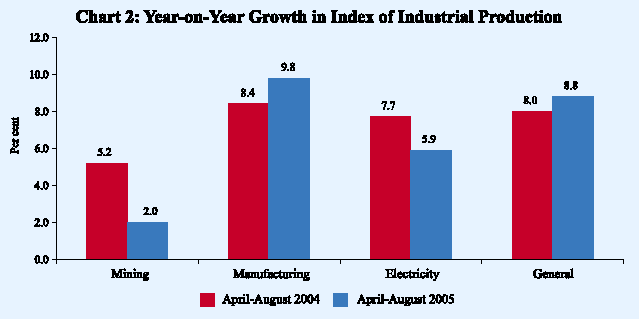
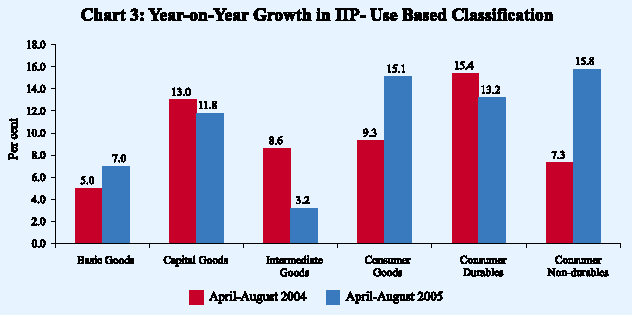
in growth of food products and a marked acceleration in growth of beverages, tobacco and related products. Intermediate goods sector, however, witnessed a subdued performance mainly on account of slack in basic chemicals and chemical products and negative growth in petroleum products (Chart 3).
At the two-digit manufacturing level, 14 out of 17 industry groups recorded a positive growth during April-August 2005. Ten industry groups recorded an accelerated growth as compared with eight industry groups in the corresponding period of the previous year. Textile products (including wearing apparel) recorded the highest growth of 21.5 per cent during April-August 2005 benefiting from the complete phase out of textile quotas effective January 2005 (Table 6).
Table 6: Growth Performance of Manufacturing Industry Groups: April-August 2005
|
Acceleration in Growth |
Deceleration in Growth |
Negative Growth |
|||
|
1. |
Textiles products (including |
1. |
Chemicals and chemical |
1. |
Wood and wood products, |
|
apparels) (21.5) |
products (12.7) |
furniture and fixtures (-1.5) |
|||
|
2. |
Beverages, tobacco and |
2. |
Machinery and equipment other |
2. |
Wool, silk and man-made fibre |
|
related products (16.8) |
than transport equipment (8.8) |
textiles (-1.8) |
|||
|
3. |
Basic metal and alloy |
3. |
Leather and leather and fur |
3. |
Metal products and parts (except |
|
industries (16.8) |
products (4.8) |
machinery and equipment) (-3.5) |
|||
|
4. |
Other manufacturing |
4. |
Rubber, plastic, petroleum and |
||
|
industries (16.3) |
coal products (3.6) |
||||
|
5. |
Transport equipment and parts (11.0) |
||||
|
6. |
Cotton textiles (10.4) |
||||
|
7. |
Paper and paper products (7.6) |
||||
|
8. |
Non-metallic mineral products (7.5) |
||||
|
9. |
Food products (5.1) |
||||
|
10. |
Jute and other vegetable |
||||
|
fibre textiles (2.7) |
|||||
|
Note: Figures in parentheses are growth rates during April-August, 2005. |
|||||
Infrastructure
During April-August 2005, the infrastructure sector continued to remain subdued on account of a decline in crude petroleum and petroleum refinery products and lower growth in electricity production (Chart 4). On the other hand, cement, finished steel and coal sectors recorded acceleration. Crude oil recorded negative growth on account of lower production due to disruption in production activity owing to break-out of fire in Mumbai High oilfield on July 27, 2005. High growth in the cement sector reflected robust demand from the construction sector as also the low base. Finished steel growth was buoyed up by domestic demand from the consumer durables, engineering and infrastructure sectors as well as global demand.
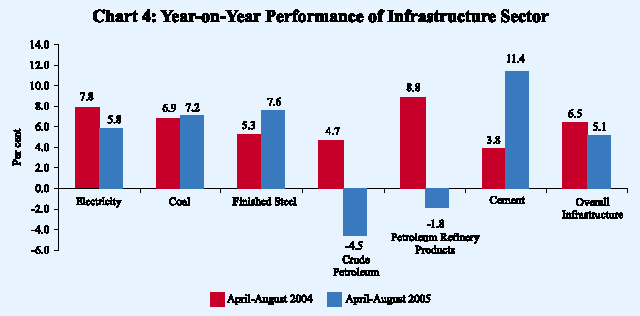
Business Expectations Surveys
Business expectation surveys suggest that industrial activity is likely to remain buoyant. The National Council for Applied Economic Research (NCAER) business confidence index (BCI) rose for the fourth successive quarter and is now at its highest level in the last ten years since December 1995 (Table 7). FICCI’s business
Table 7: Business Expectations Surveys Business Expectations
|
|
|||
|
Agency |
Growth over |
||
|
previous round |
|||
|
Expectation for |
Index |
||
|
(Per cent) |
|||
|
1 |
2 |
3 |
4 |
|
Dun & Bradstreet |
2005 (July-September) |
Business Optimism Index |
5.6 |
|
NCAER |
2005 (July-December) |
Business Confidence Index |
0.7 |
|
FICCI |
2005-06 (July-December) |
Business Confidence Index |
2.7 |
|
CII |
2005-06 (April-September) |
Business Confidence Index |
1.4 |
|
RBI |
2005-06 (October-December) |
Business Expectations Index |
2.6 |
confidence index also exhibited an improvement and revealed that the corporate houses are exuberant about their medium to long-term business outlook. According to the survey, 76 per cent of the respondents expected sales to be much higher over the next six months, 48 per cent expected ‘higher to much higher’ profits and 46 per cent are planning ‘higher to much higher’ investments. CII-ASCON survey for April-June 2005-06 also suggests the continuance of buoyant manufacturing industrial performance.
According to the Reserve Bank’s latest Industrial Outlook Survey, the Business Expectations Index for October-December 2005 quarter increased by 2.6 per cent over the previous quarter’s level (Chart 5). The assessment about the overall business situation for July-September 2005 showed the same level of confidence as in the previous quarter. The level of confidence was, however, higher than that during the corresponding quarter a year ago.
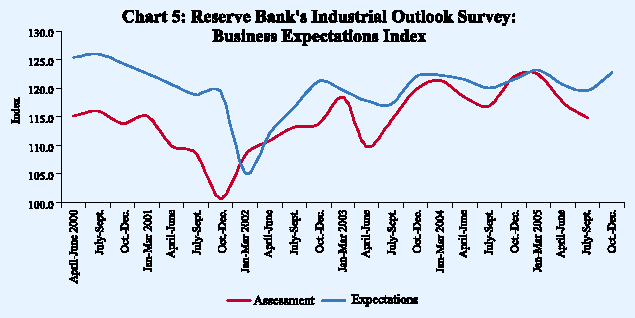
Survey results indicate that the overall business situation, financial situation, availability of finance, production, order books, capacity utilisation, employment, exports and profit margins are expected to improve during the quarter October-December 2005 vis-à-vis July-September 2005 (Table 8).
These relatively optimistic expectations are corroborated by the improvements that have taken place in corporate financial performance in recent years. As a result of stronger capitalisation and operating cash flows, overall gearing measures have improved in the Indian corporate sector. With over 97 per cent of CRISIL ratings carrying ‘stable’ outlooks, and no rating carrying a ‘negative’ outlook, the current financial health of corporate India can be adjudged to be healthy. However, there are some indications that the corporate sector will
Table 8: Net Response on ‘A Quarter Ahead’ Expectations about Industrial Performance
|
(Per cent) |
|||||||
|
Oct.- |
Jan.- |
Apr- |
July- |
Oct- |
|||
|
Parameter |
Response |
Dec. |
March |
June |
Sept. |
Dec. |
|
|
2004 |
2005 |
2005 |
2005 |
2005 |
|||
|
(955) |
(987) |
(987) |
(816) |
(961) |
|||
|
1 |
2 |
3 |
4 |
5 |
6 |
7 |
|
|
1. |
Overall business situation |
Better |
47.4 |
47.4 |
44.3 |
45.5 |
51.3 |
|
2. |
Financial situation |
Better |
37.0 |
37.5 |
36.7 |
36.7 |
42.3 |
|
3. |
Working capital finance requirement |
Increase |
30.9 |
29.2 |
27.2 |
28.8 |
32.7 |
|
4. |
Availability of finance |
Improve |
28.6 |
31.3 |
30.8 |
30.7 |
34.1 |
|
5. |
Production |
Increase |
44.5 |
45.9 |
38.7 |
40.7 |
46.9 |
|
6. |
Order books |
Increase |
42.6 |
42.2 |
37.4 |
39.6 |
43.7 |
|
7. |
Cost of raw material |
Decrease |
-39.0 |
-41.8 |
-36.7 |
-43.6 |
-30.0 |
|
8. |
Inventory of raw material |
Below average |
-4.1 |
-7.4 |
-4.3 |
-4.2 |
-6.9 |
|
9. |
Inventory of finished goods |
Below average |
-3.5 |
-5.2 |
-3.1 |
-4.2 |
-3.3 |
|
10. |
Capacity utilisation |
Increase |
27.8 |
31.3 |
27.7 |
25.4 |
31.1 |
|
11. |
Level of capacity utilisation |
Above normal |
6.3 |
12.9 |
8.1 |
7.6 |
10.9 |
|
12. |
Assessment of the production capacity |
More than adequate |
5.4 |
6.6 |
5.7 |
5.3 |
5.0 |
|
13. |
Employment in the company |
Increase |
6.0 |
8.0 |
7.7 |
7.8 |
12.7 |
|
14. |
Exports, if applicable |
Increase |
31.6 |
31.5 |
30.2 |
32.5 |
33.3 |
|
15. |
Imports, if any |
Increase |
21.3 |
22.2 |
20.3 |
23.7 |
19.2 |
|
16. |
Selling prices are expected to |
Increase |
7.6 |
8.6 |
11.0 |
13.3 |
7.8 |
|
17. |
If increase expected in selling prices |
Increase at lower rate |
9.9 |
8.2 |
13.5 |
14.0 |
16.6 |
|
18. |
Profit margin |
Increase |
4.4 |
5.6 |
6.3 |
7.1 |
9.6 |
|
Note: 1. Figures in parentheses represent number of companies covered in the Survey. |
|||||||
have to be watchful in the short to medium term future with the possible unfolding of potential risks. These risks could emanate from the sharp increases in oil prices, plateauing of growth rates in some key industries and infrastructure constraints. Furthermore, with the manufacturing sector operating at high capacity utilisation levels, significant growth over the medium to long term will call for fresh investments that could also involve higher borrowing, and consequent exposure to associated risks and possible deterioration of gearing ratios. Illustratively, a recent analysis of trends in its ratings by CRISIL shows that the modified credit ratio (the ratio of upgrades plus reaffirmations to downgrades plus reaffirmations) dropped after three years of increase - it fell to 1.05 during April-September 2005 from the all time high of 1.16 in 2004-05. With the ratio remaining above 1.0 indicating continuing credit health of the corporate sector, this change points to the stiffer challenges that could be in store for corporate India in maintaining or improving its credit quality in the short to medium term.
Table 9: Indicators of Service Sector Activity
|
(Growth rates in per cent) |
||
|
Sub-sector |
April-August 2004 |
April-August 2005 |
|
1 |
2 |
3 |
|
Tourist arrivals |
26.4 |
26.0 |
|
Commercial vehicles production |
41.4 |
11.6 |
|
Railway revenue earning freight traffic |
6.3 |
10.9 |
|
New cell phone connections |
31.9 |
34.3 |
|
Cargo handled at major ports |
10.3 |
13.6 |
|
Civil aviation |
||
|
a) Export cargo handled (April-July) |
7.5 |
9.1 |
|
b) Import cargo handled (April-July) |
36.8 |
7.8 |
|
c) Passengers handled at international terminals (April-July) |
18.5 |
12.5 |
|
d) Passengers handled at domestic terminals (April-July) |
26.8 |
20.4 |
|
Roads: Upgradation of Highways (April-July) |
-3.1 |
-0.7 |
|
Cement |
3.8 |
11.4 |
|
Steel |
5.3 |
7.6 |
|
Aggregate deposits (April-September) |
6.8 |
12.3 |
|
Non-food credit (April-September) |
11.9 |
14.8 |
|
Central Government expenditure |
32.1 |
33.2 |
Services Sector
Services sector growth during the first quarter of 2005-06 accelerated to 9.6 per cent from 9.1 per cent a year ago, led by all its major constituent sectors (see Table 1). The growth of the ‘trade, hotels, restaurants, transport, storage and communication’ sub-sector, apart from reflecting the upbeat economic climate in the country, benefited from strong tourist arrivals, higher traffic handled by the railways, increased cargo handled at major ports, growth in cargo and passengers handled by civil aviation, and the continued surge in cell phone connections. Financing, real estate and business services were propelled by the Information Technology (IT) and IT Enabled Services and Business Process Outsourcing, and upsurge in bank credit. Construction sector recorded a higher growth in consonance with the uptrend in cement production. Latest available information on the major indicators of services sector indicates continued buoyancy in the second quarter of 2005-06 (Table 9).
The revival of the South-West monsoon, the acceleration of the industry, buoyancy in services and positive business confidence and expectations have improved growth prospects for 2005-06. The forecasts by different agencies and institutions for the overall growth during 2005-06 are set out in Table 10.
Table 10: Projections of Real Gross Domestic Product for India by Various Agencies for 2005-06
|
Agency |
Projections (Per cent) |
Assumptions (Sectoral) |
Month of Projections |
|
1 |
2 |
3 |
4 |
|
ADB |
6.9 |
Normal monsoon. |
September, 2005 |
|
Agriculture 4.4 per cent |
|||
|
Industry 6.7 per cent |
|||
|
Services 7.7 per cent |
|||
|
BIS |
7.1 |
June, 2005 |
|
|
CII |
a) 7.2 |
Agriculture 3.0 per cent |
end-May, 2005 |
|
Industry 8.1 per cent |
|||
|
Services 8.3 per cent |
|||
|
b) 7.3 |
Agriculture 3.2 per cent |
October, 2005 |
|
|
CMIE |
a) 6.0 |
Agriculture (-) 0.7 per cent |
June 2005 |
|
Industry 8.5 per cent |
|||
|
Services 7.5 per cent |
|||
|
b) 6.8 |
Agriculture 3.0 per cent |
August, 2005 |
|
|
Industry 8.5 per cent |
|||
|
Services 7.5 per cent |
|||
|
CRISIL |
a) 7.0 |
Agriculture 3.0 per cent |
May, 2005 |
|
Industry 7.0 per cent |
|||
|
Services 8.6 per cent |
|||
|
b) 7.0 |
Agriculture 2.5 per cent |
September, 2005 |
|
|
Industry 7.4 per cent |
|||
|
Services 8.5 per cent |
|||
|
NCAER |
a) 7.2 |
Mid-May, 2005 |
|
|
b) 7.05-7.1 |
Agriculture 2.5 per cent |
July, 2005 |
|
|
Industry 7.54 per cent |
|||
|
Services 8.55 per cent |
|||
|
IMF |
a) 6.7 |
April, 2005 |
|
|
b) 7.1 |
September, 2005 |
||
|
Ministry of |
7.0 |
Normal monsoon |
May, 2005 |
|
Finance |
Agriculture 3.0 per cent |
||
|
Industry and Services expected to perform well |
|||
|
Reserve |
Around 7.0 |
Normal monsoon |
April, 2005 |
|
Bank of |
Agriculture 3.0 per cent |
||
|
India |
Industry and Services expected to maintain |
||
|
current growth momentum. |






















